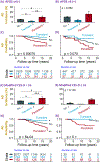Associations of loneliness with risk of Alzheimer's disease dementia in the Framingham Heart Study
- PMID: 33760348
- PMCID: PMC8460688
- DOI: 10.1002/alz.12327
Associations of loneliness with risk of Alzheimer's disease dementia in the Framingham Heart Study
Abstract
Introduction: The relationship between persistent loneliness and Alzheimer's disease (AD) is unclear. We examined the relationship between different types of mid-life loneliness and the development of dementia and AD.
Methods: Loneliness was assessed in cognitively normal adults using one item from the Center for Epidemiologic Studies Depression Scale. We defined loneliness as no loneliness, transient loneliness, incident loneliness,or persistent loneliness, and applied Cox regression models and Kaplan-Meier plots with dementia and AD as outcomes (n = 2880).
Results: After adjusting for demographics, social network, physical health, and apolipoprotein E ε4, persistent loneliness was associated with higher (hazard ratio [HR], 1.91; 95% confidence interval [CI] 1.25-2.90; P < .01), and transient loneliness with lower (HR, 0.34; 95% CI 0.14-0.84; P < .05), risk of dementia onset, compared to no loneliness. Results were similar for AD risk.
Discussion: Persistent loneliness in mid-life is an independent risk factor for dementia and AD, whereas recovery from loneliness suggests resilience to dementia risk.
Keywords: apolipoprotein E ε4; brain health; cognitive function; cohort study; depression; healthy aging; longitudinal; mental health; population-based; prevention; social isolation.
© 2021 the Alzheimer's Association.
Figures


References
-
- Peplau LA, Perlman D. Perspectives on loneliness. In: Peplau LA, Perlman D, eds. Loneliness: A source-book of current theory, research and therapy. New York (US): Wiley; 1982:1–8.
Publication types
MeSH terms
Grants and funding
LinkOut - more resources
Full Text Sources
Other Literature Sources
Medical

